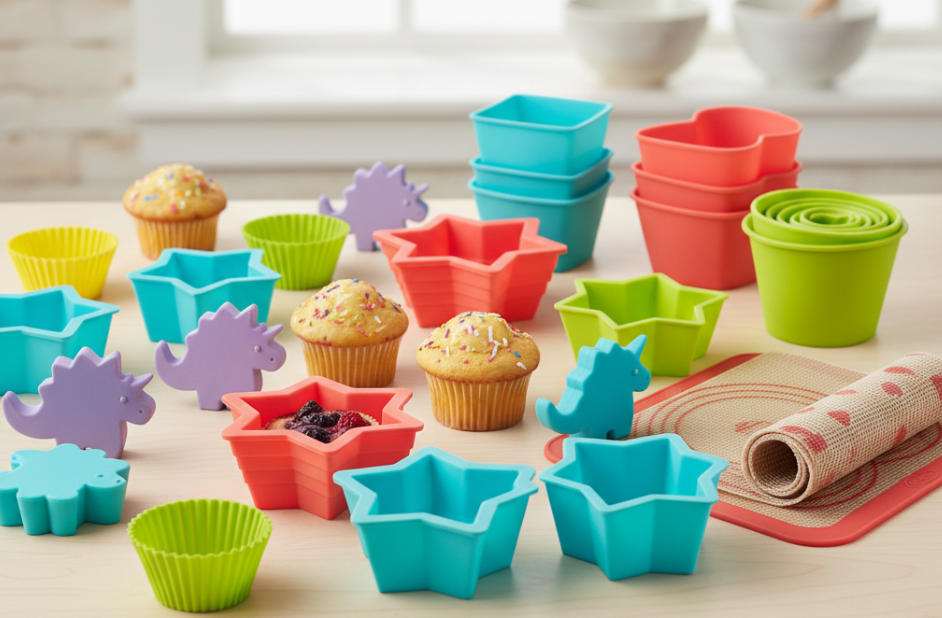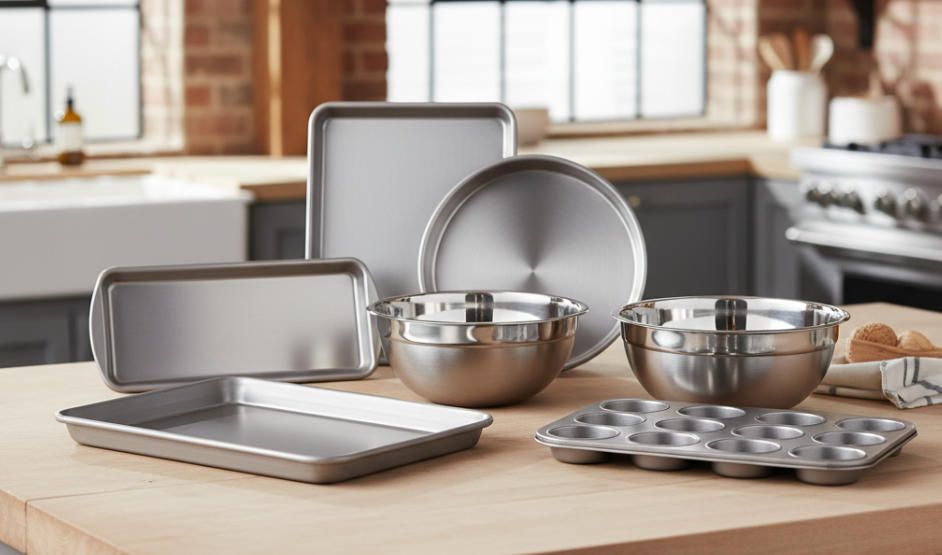Choosing between trendy silicone and classic stainless steel is tough. The wrong choice can hurt your profits and brand reputation. Let's find the best fit for your market.
Stainless steel is ideal for building a premium brand with its durability1 and professional feel, targeting supermarkets and specialty stores. Silicone offers flexibility for e-commerce2, seasonal items3, and creative designs4. Your choice should depend on your market, brand strategy, and long-term goals.

After 27 years in the stainless steel kitchenware business, I've seen many trends come and go. Today, the choice between silicone and stainless steel isn't just about cost. It's about finding products with long-term, sustainable selling power. Many of our partners ask me which material they should invest in. To help you decide, let's break down the real-world advantages and disadvantages of each material for your specific business needs.
Does Silicone Offer More Flexibility for E-Commerce and Seasonal Sales?
E-commerce demands eye-catching, shippable products. Bulky, plain bakeware often gets lost in a crowded online marketplace. Silicone’s creative shapes and light weight can be a major advantage.
Yes, silicone is highly flexible for e-commerce. Its lightweight nature reduces shipping costs5, and it can be molded into unique, colorful shapes perfect for gift sets and seasonal promotions. This makes it ideal for capturing online shoppers' attention and testing new product ideas with lower risk.

From my experience working with online sellers, silicone's biggest advantage is its marketing appeal. It's perfect for creating themed gift boxes for holidays or special occasions. The vibrant colors and fun shapes photograph well, which is a huge plus for social media and online listings. Because it's lightweight and unbreakable, it significantly cuts down on shipping costs and damage claims, which directly impacts your bottom line. However, we must also consider the downsides. Silicone's flexibility can be a problem; it often requires a metal frame for stability. It can also retain odors and stains over time, which may lead to customer complaints6. It works best for businesses that focus on fast-moving, trend-driven products rather than building a reputation on lifetime durability.
Silicone Bakeware: E-Commerce & Seasonal Sales Breakdown
| Aspect | Advantages | Disadvantages |
|---|---|---|
| Design | Highly creative, endless shapes and colors. | Can look less professional or "serious". |
| Shipping | Lightweight, reducing logistics costs. | May require extra packaging for stability. |
| Durability | Flexible and won't dent or break. | Prone to tearing, staining, and odor retention. |
| Market Fit | Excellent for gift sets, seasonal items, and trends. | Not ideal for building a premium, long-lasting brand. |
Is Stainless Steel the Key to Building a Long-Term, Premium Brand?
Building a trusted kitchenware brand is a challenge. Flimsy products can lead to bad reviews and high return rates, damaging your reputation. Stainless steel offers a solution for this.
Yes, stainless steel is the foundation for a premium brand. Its durability, professional look, and excellent performance create high perceived value7. This leads to better customer satisfaction, lower return rates, and the kind of brand loyalty8 that supports long-term growth in major retail channels.

When we work with partners aiming to get their products into big-box retailers or specialty kitchen stores, we always recommend stainless steel. The initial investment and shipping costs are higher, there's no doubt about that. But the long-term value is unmatched. Customers who buy stainless steel expect it to last for years, and it does. This builds incredible trust. We’ve seen that products made from high-quality stainless steel have a much lower return rate, which is a critical metric for any importer. It withstands high heat without warping, distributes heat evenly for perfect baking results, and is easy to clean. This level of performance is what creates repeat customers and positive word-of-mouth, solidifying your brand as a reliable, high-quality choice in a competitive market. It’s not just a product; it’s a long-term asset for your brand.
Stainless Steel Bakeware: Brand Building Breakdown
| Aspect | Advantages | Disadvantages |
|---|---|---|
| Quality | High perceived value, durable, and rust-resistant. | Higher initial manufacturing cost. |
| Performance | Excellent heat distribution, warp-resistant. | Can have sticking issues without proper greasing. |
| Longevity | Lasts for decades, building customer trust. | Heavier, leading to higher shipping costs. |
| Market Fit | Ideal for supermarkets, professional channels, brand building. | Less suited for novelty or short-term trends. |
How Do You Choose the Right Bakeware for Your Business Strategy?
You understand the pros and cons of each material. But now you must connect this knowledge to your business goals. Making the wrong choice can mean missed opportunities or excess inventory.
The right choice depends entirely on your market focus9. For broad, stable markets like supermarkets and professional kitchen supply stores, stainless steel is the safer, more profitable long-term investment10. For nimble, trend-focused e-commerce or seasonal campaigns, silicone offers unbeatable flexibility and marketing appeal.
I always advise my clients to think about their brand identity and distribution channels first. If your goal is to become a trusted name in kitchenware, supplying major retailers where quality and durability are paramount, you should prioritize stainless steel. It helps you build a strong brand barrier that competitors can't easily break. The higher cost is justified by higher retail prices and customer loyalty. On the other hand, if your business model is based on agility—launching diverse product lines on Amazon, running seasonal promotions, or creating unique gift bundles—then silicone is your best friend. It allows you to test the market with a lower upfront investment and react quickly to new trends. Many successful importers use a hybrid approach11: a core line of stainless steel staples and a rotating collection of silicone items for seasonal flair. This balances long-term stability with short-term sales opportunities.
Strategic Fit: Silicone vs. Stainless Steel
| Business Goal | Recommended Material | Why It Fits Your Strategy |
|---|---|---|
| Build a Premium Brand | Stainless Steel | Creates a reputation for quality, durability, and performance. |
| Target Supermarkets | Stainless Steel | Meets consumer expectations for long-lasting, reliable bakeware. |
| Dominate E-Commerce | Silicone | Lightweight, photogenic, and perfect for dropshipping and online ads. |
| Launch Seasonal Products | Silicone | Low-cost molds allow for quick creation of holiday-themed items. |
| Supply Professional Kitchens | Stainless Steel | Withstands heavy use and provides consistent, professional results. |
Conclusion
Ultimately, choosing silicone or stainless steel depends on your market, brand, and long-term vision. One builds trends, while the other builds trust. Decide which is most valuable to you.
Learn why durability is a key factor in customer satisfaction and brand reputation. ↩
Discover strategies to enhance your kitchenware's appeal in the competitive e-commerce landscape. ↩
Find out how to effectively market seasonal items to boost sales during holidays. ↩
Understand the role of innovative designs in attracting customers and driving sales. ↩
Get tips on minimizing shipping expenses while maintaining product quality. ↩
Explore the issues customers face with silicone products and how to address them. ↩
Discover factors that enhance the perceived value of kitchenware products. ↩
Learn effective strategies to foster customer loyalty and repeat purchases. ↩
Find guidance on aligning your product offerings with your target market. ↩
Understand the benefits of investing in durable materials for kitchenware. ↩
Learn how combining different materials can optimize your product strategy. ↩